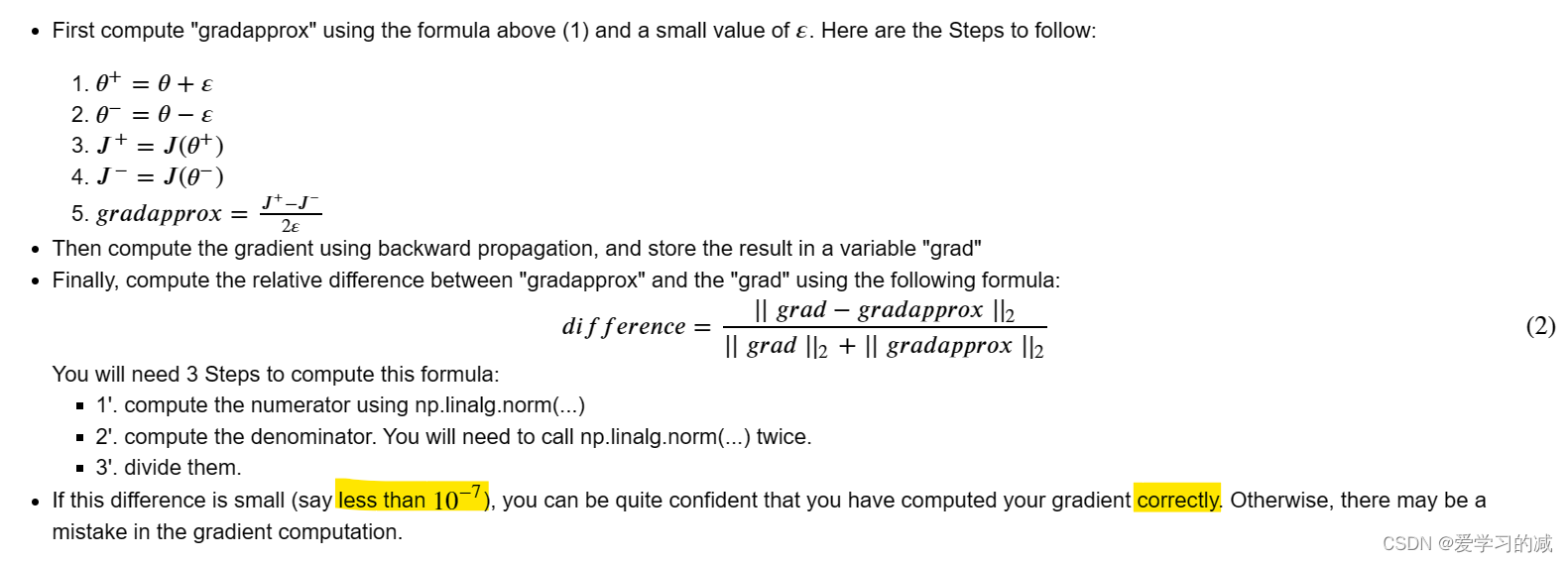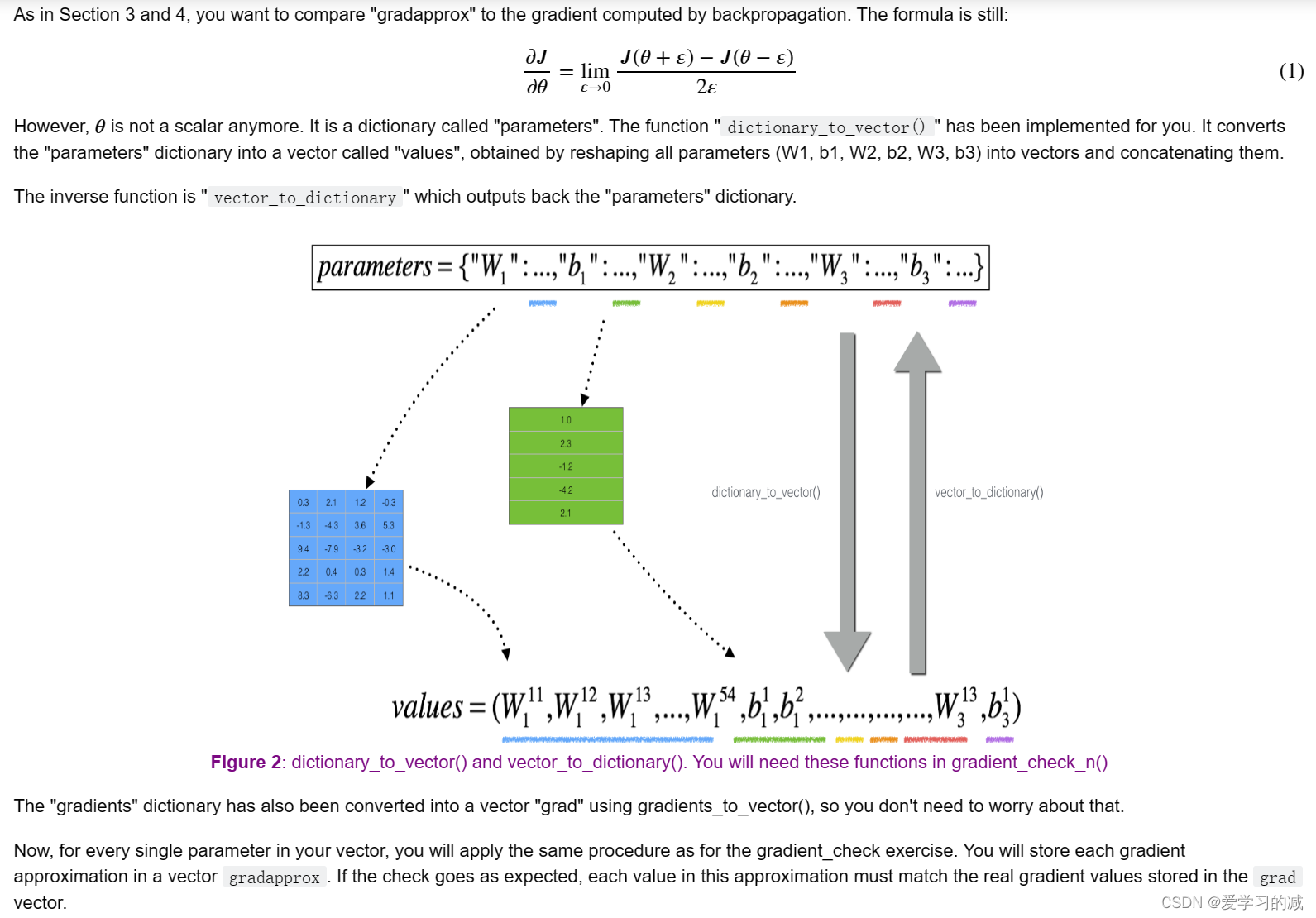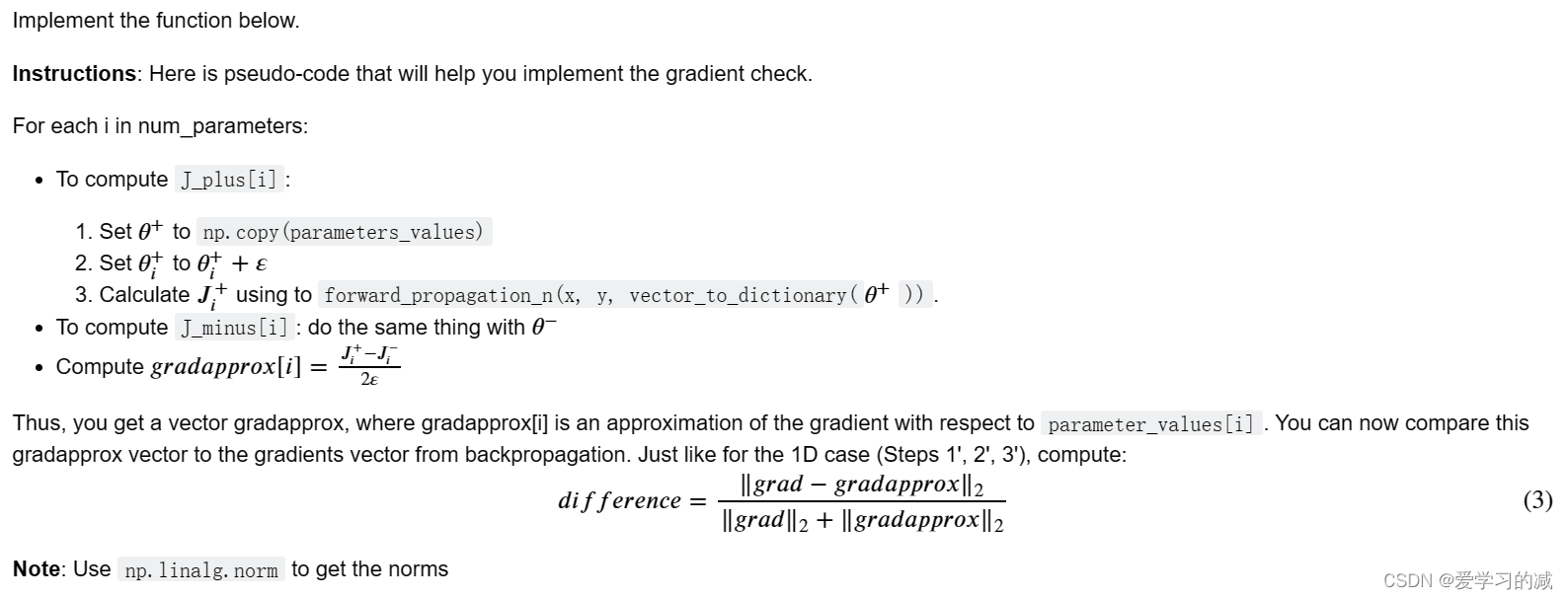吴恩达深度学习l2week1编程作业—Gradient Checking(中文跑通版)
1.Packages
import numpy as np
from testCases import *
from public_tests import *
from gc_utils import sigmoid, relu, dictionary_to_vector, vector_to_dictionary, gradients_to_vector
%load_ext autoreload
%autoreload 22.问题描述
你是一个致力于在全球范围内提供移动支付的团队的一员,并被要求建立一个深度学习模型来检测欺诈行为——每当有人付款时,你都想看看付款是否可能是欺诈性的,比如用户的账户是否被黑客接管。
您已经知道,反向传播的实现非常具有挑战性,有时还会出现错误。因为这是一个任务关键型应用程序,您公司的首席执行官希望真正确定您的反向传播实施是正确的。你的首席执行官说:“给我证据,证明你的反向传播确实有效!”为了保证这一点,你将使用“梯度检查”
让我们来做吧!
3.Gradient Checking是如何工作的?
反向传播计算梯度𝐽?/𝐽𝜃,𝜃表示模型的参数。𝐽是使用前向传播和损失函数计算的。
𝐽是使用前向传播和损失函数计算的。因为前向传播相对容易实现,所以您确信自己做对了,因此您几乎100%确信自己正在计算成本𝐽正确地。因此,您可以使用代码进行计算𝐽验证用于计算的代码𝐽?/𝐽𝜃

标黄的地方是目的
4.一维梯度检查

Exercise 1 - forward_propagation
实现正向传播。对于这个简单的函数计算𝐽(.)
def forward_propagation(x, theta):
"""
实现图1中所示的线性正向传播(计算J)(J(θ)=θ*x)
x——实值输入
θ——我们的参数,也是一个实数
J——函数J的值,使用公式J(θ)=θ*x计算
"""
J = x * theta
return Jx, theta = 2, 4
J = forward_propagation(x, theta)
print ("J = " + str(J))
forward_propagation_test(forward_propagation)
Exercise 2 - backward_propagation?
现在,实现图1中的反向传播步骤(导数计算)。也就是,计算关于𝜃的导数𝐽(𝜃)=𝜃𝑥 ,得到𝑑𝑡?𝑒𝑡𝑎=?𝐽/?𝜃=x
def backward_propagation(x, theta):
"""
计算J相对于θ的导数(见图1)。
dtheta——成本相对于θ的梯度
"""
dtheta = x
return dthetax, theta = 3, 4
dtheta = backward_propagation(x, theta)
print ("dtheta = " + str(dtheta))
backward_propagation_test(backward_propagation)![]()
Exercise 3 - gradient_check
为了证明backward_progation()函数正确地计算了梯度?𝐽/?𝜃,让我们实现梯度检查:

numerator 分子;denominator 分母
def gradient_check(x, theta, epsilon=1e-7, print_msg=False):
"""
实现图1中所示的梯度检查
x——float输入
theta——我们的参数,也是一个float
ε——输入的微小偏移,用公式(1)计算近似梯度
difference——近似梯度和反向传播梯度之间的difference(2) float输出
"""
# Compute gradapprox using right side of formula (1). epsilon is small enough, you don't need to worry about the limit.
theta_plus = theta + epsilon # Step 1
theta_minus = theta - epsilon # Step 2
J_plus = forward_propagation(x,theta_plus) # Step 3
J_minus = forward_propagation(x,theta_minus) # Step 4
gradapprox = (J_plus + J_minus)/(2 * theta) # Step 5
# Check if gradapprox is close enough to the output of backward_propagation()
grad = backward_propagation(x, theta)
numerator = np.linalg.norm(gradapprox - grad) # Step 1'
denominator = np.linalg.norm(gradapprox) + np.linalg.norm(grad) # Step 2'
difference = numerator / denominator # Step 3'
if print_msg:
if difference > 2e-7:
print ("\033[93m" + "There is a mistake in the backward propagation! difference = " + str(difference) + "\033[0m")
else:
print ("\033[92m" + "Your backward propagation works perfectly fine! difference = " + str(difference) + "\033[0m")
return differencex, theta = 3, 4
difference = gradient_check(x, theta, print_msg=True)
Your backward propagation works perfectly fine! difference = 0.0
5.N维梯度检查

def forward_propagation_n(X, Y, parameters):
"""
实现图3中所示的正向传播(并计算成本)
X——m个例子的训练集
Y——m个示例的标签
parameters--包含参数“W1”、“b1”、“W2”、“b2”、“W3”、”b3“的python字典:
W1——形状(5,4)的权重矩阵
b1——形状(5,1)的偏置矢量
W2——形状(3,5)的权重矩阵
b2——形状(3,1)的偏置矢量
W3——形状(1,3)的权重矩阵
b3——形状(1,1)的偏置矢量
成本——成本函数(m个例子的成本)
cache——具有中间值(Z1、A1、W1、b1、Z2、A2、W2、b2、Z3、A3、W3、b3)的元组
"""
# retrieve parameters
m = X.shape[1] #columns or features
W1 = parameters["W1"]
b1 = parameters["b1"]
W2 = parameters["W2"]
b2 = parameters["b2"]
W3 = parameters["W3"]
b3 = parameters["b3"]
# LINEAR -> RELU -> LINEAR -> RELU -> LINEAR -> SIGMOID
Z1 = np.dot(W1, X) + b1
A1 = relu(Z1)
Z2 = np.dot(W2, A1) + b2
A2 = relu(Z2)
Z3 = np.dot(W3, A2) + b3
A3 = sigmoid(Z3)
# Cost
log_probs = np.multiply(-np.log(A3),Y) + np.multiply(-np.log(1 - A3), 1 - Y)
cost = 1. / m * np.sum(log_probs)
cache = (Z1, A1, W1, b1, Z2, A2, W2, b2, Z3, A3, W3, b3)
return cost, cachedef backward_propagation_n(X, Y, cache):
"""
实现图2中所示的反向传播
X——输入数据点,形状(输入大小,1)
Y——真“标签”
cache—缓存forward_propation_n()的输出
梯度——一个字典,包含每个参数、激活和预激活变量的成本梯度
"""
m = X.shape[1]
(Z1, A1, W1, b1, Z2, A2, W2, b2, Z3, A3, W3, b3) = cache
dZ3 = A3 - Y
dW3 = 1. / m * np.dot(dZ3, A2.T)
db3 = 1. / m * np.sum(dZ3, axis=1, keepdims=True)
dA2 = np.dot(W3.T, dZ3)
dZ2 = np.multiply(dA2, np.int64(A2 > 0))
dW2 = 1. / m * np.dot(dZ2, A1.T) * 2
db2 = 1. / m * np.sum(dZ2, axis=1, keepdims=True)
dA1 = np.dot(W2.T, dZ2)
dZ1 = np.multiply(dA1, np.int64(A1 > 0))
dW1 = 1. / m * np.dot(dZ1, X.T)
db1 = 4. / m * np.sum(dZ1, axis=1, keepdims=True)
gradients = {"dZ3": dZ3, "dW3": dW3, "db3": db3,
"dA2": dA2, "dZ2": dZ2, "dW2": dW2, "db2": db2,
"dA1": dA1, "dZ1": dZ1, "dW1": dW1, "db1": db1}
return gradients如果您刚刚实现了这些功能,您可能对它们是否正确工作没有很高的信心。因此,让我们实现梯度检查来帮助验证性能。
梯度检查是如何工作的?

请注意,grad是使用函数gradients_to_vector计算的,该函数使用backward_propation_n函数的梯度输出。
Exercise 4 - gradient_check_n

def gradient_check_n(parameters, gradients, X, Y, epsilon=1e-7, print_msg=False):
"""
检查backward_progration_n是否正确计算了forward_progation_n输出的成本梯度
parameters--包含参数“W1”、“b1”、“W2”、“b2”、“W3”、”b3“的python字典
grad——backward_propation_n的输出,包含相对于参数的成本梯度
X——输入数据点,形状(输入大小,示例数)
Y——真“标签”
ε——输入的微小偏移,用公式(1)计算近似梯度
差——近似梯度和反向传播梯度之间的差(2)
"""
def gradient_check_n(parameters, gradients, X, Y, epsilon=1e-7, print_msg=False):
# Set-up variables
parameters_values, _ = dictionary_to_vector(parameters)
grad = gradients_to_vector(gradients)
num_parameters = parameters_values.shape[0]
J_plus = np.zeros((num_parameters, 1))
J_minus = np.zeros((num_parameters, 1))
gradapprox = np.zeros((num_parameters, 1))
# Compute gradapprox
for i in range(num_parameters):
# Compute J_plus[i]. Inputs: "parameters_values, epsilon". Output = "J_plus[i]".
thetaplus = np.copy(parameters_values)
thetaplus[i][0] = thetaplus[i][0] + epsilon
J_plus[i], _ = forward_propagation_n(X, Y, vector_to_dictionary(thetaplus))
# Compute J_minus[i]. Inputs: "parameters_values, epsilon". Output = "J_minus[i]".
thetaminus = np.copy(parameters_values)
thetaminus[i][0] = thetaminus[i][0] - epsilon
J_minus[i], _ = forward_propagation_n(X, Y, vector_to_dictionary(thetaminus))
# Compute gradapprox[i]
gradapprox[i] = (J_plus[i] - J_minus[i]) / (2 * epsilon)
# Compare gradapprox to backward propagation gradients by computing difference.
numerator = np.linalg.norm(grad - gradapprox) # Move this outside the loop
denominator = np.linalg.norm(grad) + np.linalg.norm(gradapprox) # Move this outside the loop
difference = numerator / denominator
if print_msg:
if difference > 2e-7:
print("\033[93m" + "There is a mistake in the backward propagation! difference = " + str(difference) + "\033[0m")
else:
print("\033[92m" + "Your backward propagation works perfectly fine! difference = " + str(difference) + "\033[0m")
return differenceX, Y, parameters = gradient_check_n_test_case()
cost, cache = forward_propagation_n(X, Y, parameters)
gradients = backward_propagation_n(X, Y, cache)
difference = gradient_check_n(parameters, gradients, X, Y, 1e-7, True)
expected_values = [0.2850931567761623, 1.1890913024229996e-07]
assert not(type(difference) == np.ndarray), "You are not using np.linalg.norm for numerator or denominator"
assert np.any(np.isclose(difference, expected_values)), "Wrong value. It is not one of the expected values"Your backward propagation works perfectly fine! difference = 1.1890913024229996e-07
本文来自互联网用户投稿,该文观点仅代表作者本人,不代表本站立场。本站仅提供信息存储空间服务,不拥有所有权,不承担相关法律责任。 如若内容造成侵权/违法违规/事实不符,请联系我的编程经验分享网邮箱:veading@qq.com进行投诉反馈,一经查实,立即删除!